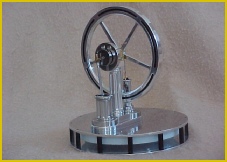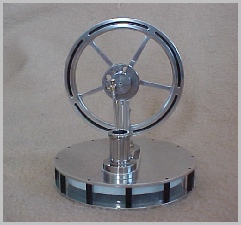












Sage Model Engines


The Miser

Although Jerry passed away in 2009, his Son has continued to sell Jerry’s plans and to support builders the best he can. A link to the website is here.
He offers plans and hard-to-find parts kits for a selection of the wonderful engines designed by Jerry.




The Miser - Low temperature differential Stirling engine


The Miser is a low temperature differential Stirling engine designed by Jerry Howell. If carefully made it will run on the heat of your hand.

As with all stirling engines the Miser consists of a displacer and a power piston. The displacer in this engine is a large blue styrofoam disk enclosed in the bottom of the engine. It can be seen through the clear plexiglass sides of the displacer cylinder in the picture. The displacer is a loose fit inside the cylinder and is supported by a thin rod in it’s center. The rod passes through a seal and is connected to one side of the crankshaft at the top (right picture above). The power piston is graphite and is inside the stainless power cylinder (left picture above). It is also connected to the crankshaft opposite the displacer rod. A small hole connects the bottom of the power cylinder into the displacer cylinder. Otherwise the displacer cylinder is a sealed container. In operation, the bottom aluminum plate of the closed displacer cylinder is typically placed on a source of heat. Something like a hot cup of coffee works well. The top plate of the displacer cylinder is at ambient temperature. We start the description of operation with the foam displacer at the top inside the cylinder. The power piston would be at the bottom of it’s stroke. The heat from below warms the air in the displacer cylinder and the pressure increases. The pressure increase causes the graphite power piston to be pushed up in it’s cylinder and to turn the crank. Since the displacer is also connected to the crank, the displacer is lowered in the cylinder. Since it is loose fit, the warm air is displaced and passes around the sides of the foam displacer piston and is forced to the top of the cylinder where it comes in contact with the cooler aluminum plate on top and begins to cool. The pressure inside the displacer cylinder and therefore the power cylinder drops and the power piston is pulled back down. The crankshaft then reacts by moving the displacer back up in the cylinder displacing the now cooler air back to the warm plate on the bottom. This cycle repeats and the flywheel rotates at perhaps 100rpm depending on the temperature differential between the bottom and top plates. In fact the engine can run backwards if the bottom plate is cooled instead of heated. If well crafted the engine will operate on temperature differences of perhaps 15degC.
